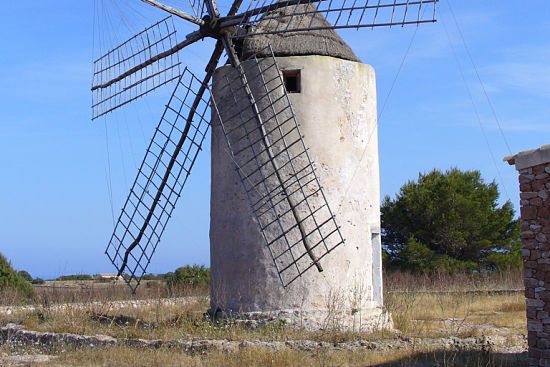
Route through the mills of Formentera
- entradilla: Formentera has lived on fishing and agriculture practically until the 60’s. For this reason, in Aquabus we propose an alternative route to the beach getaway, enjoying the most agricultural Formentera: visiting its windmills.
Formentera has lived on fishing and agriculture practically until the 60’s. For this reason, in Aquabus we propose an alternative route to the beach getaway, enjoying the most agricultural Formentera: visiting its windmills. During the sixteenth century, windmills began to be installed in Spain, whether they were of the salt type, potters, water extraction, etc. In the case of Formentera, 7 flour mills were built, the most common at the time. Formentera was known as “the land of wheat”, from which it takes its name (frumentaria, which in Latin means “pertaining to wheat”).
Of these seven flour mills, today there are six, standing five, which are those that can be visited by tourists. There are two mills in Sant Francesc Xavier, the Molí den Mateu in 1773 and the Molí d’en Gerona in 1760; one in Sant Ferran, Molí den Tauet, 1760; and two in La Mola -both of 1893- Molí d’en Simon and the Molí d’en Botiga, of which only the tower remains. There was also another mill (the sixth) in Es Cap de Barbaria, of which only the foundations remain.
These classic windmills, whitewashed and huge wooden blades, from the eighteenth century and until the end of the last century, are an icon of the most traditional Formentera. They usually have three floors; in the highest is the machinery and the grinding stone, in the middle the elements for collecting the flour; and, finally, on the ground floor, the warehouse. Its conical roof moves to guide the blades to the most favorable wind.
The function of the seven mills was to grind the flour, but in some cases salt was also milled, as was the case in Molins de Ferrer. The Molí Vell de la Mola belonged to his family for 200 years and was used until 1956. The first reference is of 1778 and, thanks to the restoration carried out by the Consell Insular d’Eivissa i Formentera, it is currently the best conserved of Formentera
The Molí Vell de la Mola is located in the town of La Mola. There are other attractions such as the hippie market or the lighthouse that is located on the cliffs. By the road that goes to the same Lighthouse, we find on the right the detour to see this mill. At the moment it has an owner and responsible, in charge of the access to visit it explaining its history, antiquity and its use to grind the wheat.
The mills of Formentera are a must if you come to the island, being able to make the trip in the transport you prefer. You can take this trip not only for your visit, but also to know the locations where they are located, as well as the cuisine they offer. The path to them is a beautiful landscape of pine trees and coasts, culminating with a viewpoint before arriving. The spectacular views combine the best of the cliffs, the sea and the more rustic Formentera.
- Hits: 461




